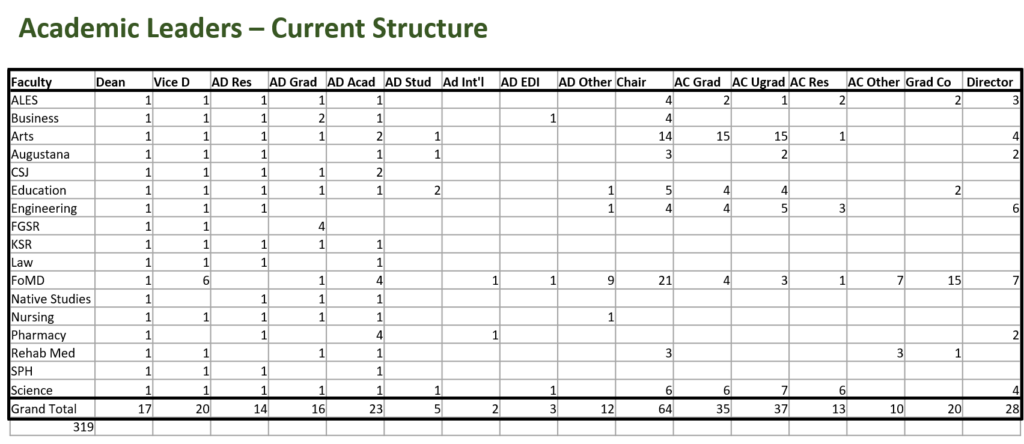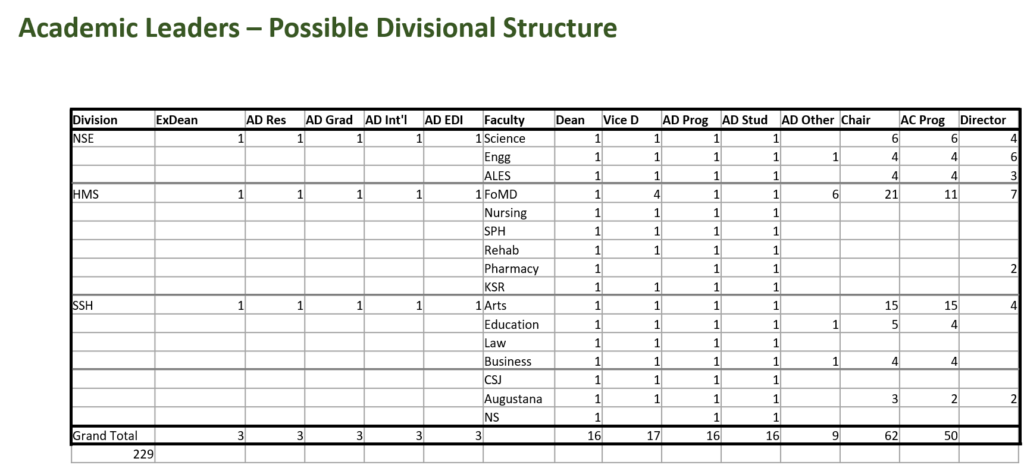Proposed academic restructuring scenario could cut 84 academic leadership positions
At a GFC Academic Planning Committee meeting, it was revealed that 84 positions could be lost under the favoured academic restructuring scenario
 Christien Ford
Christien FordThis article is part of The Gateway’s ongoing coverage of academic restructuring at the University of Alberta. You can read about the previous June townhall , presentation at Students’ Council, and release of the interim report.
Of the the three academic restructuring scenarios being considered, the one most favoured by University of Alberta administration would significantly downsize academic leadership.
The U of A released its interim academic restructuring proposal on September 21. In it, the Academic Restructuring Working Group (ARWG) — who has been exploring academic restructuring since May — suggested three possible scenarios. These include creating a consolidated health sciences faculty, creating a tri-agency alignment consisting of 13 faculties sorted into three “divisions,” and a hybrid model consolidating various faculties while also placing facilities into one overseing division.
In the report, ARWG suggested the tri-agency alignment as the best scenario for the university, citing $43 million in overall savings.

At an Academic Planning Committee (APC) meeting, a sub-committee of the highest academic governing body General Faculties Council (GFC), the proposed savings of this scenario were contextualized in terms of eliminating 84 academic leadership positions.
According to Steven Dew, provost and vice-dean (academic), there are currently 319 academic leadership roles amongst faculties. These positions include deans, vice-deans, assistant deans, chairs, assistant chairs, and directors.

Under the tri-agency alignment scenario, a new academic leadership hierarchy could be created, with each of the three divisions containing an executive dean accompanied by assistant deans for graduate students, research, international students, and equity, diversity, and inclusion (EDI).
Each faculty, will then consist of a dean, vice-dean, and assistant deans, with other positions such as chairs and directors for select faculties.
This structure will not be reflected in the faculty of graduate studies and research, who will keep all 6 of its positions. It will also not be reflected by the faculties of native studies, Augustana, and Campus Saint-Jean, which remain independent in this restructuring scenario.
This possible new hierarchy can cut roughly 84 academic leaders, leaving 229 overall positions excluding positions in the faculty of graduate studies and research.

Though this exact structure is not set in stone, Dew emphasized a large goal of the tri-agency scenario is reducing lower hierarchy roles, which can be quite numerous with 66 departments.
“If we’re going to have 66 departments, any function we have at the department level gets multiplied 66 times whereas if we have the function at the faculty level it gets multiplied 18 times,” he explained. “If we add it at the division level, they are multiplied three times.”
Citing how some faculties lack an EDI-dedicated position, Dew pointed out that creating roles at the division level will create equalized resources for faculties.
“Not every faculty is able to have someone who’s thinking of elements of equity, diversity, and inclusivity,” he said. “This gives us the ability to have somebody embedded in the academy thinking deeply about how to support EDI across the suite of programs.”
Dew also also mentioned that this possible scenario will enable more complete, functional teams in the academic sphere, something he didn’t always have in his previous role.
“As a former associate dean research, I was largely on my own,” Dew recalled. “Anything I did I did myself back then — if there was photo copying, it probably landed on me.”
APC members worried about work distribution under possible new hierarchy
Pirkko Marcula-Dension, a kinesiology, sport, and recreation professor, raised concerns about the workload of the newly envisioned assistant deans. Using research as an example, she brought forth concerns about the ability of one person to support the research of multiple faculties.
“These divisions are quite huge and they are not uniform,” she said. “This might be too large of an ask [from associate dean (research)] and I’m not sure who would be able to do that job.”
“Researches have assumptions,” she added. “You need a very special person who can appreciate everybody’s assumptions and then can, in an equitable manner, promote all different kinds of research in these very diverse [divisions].”
Kisha Supernant, an anthropology associate professor, also raised concerns about individuals co-opting the work of the 84 lost positions without being compensated.
“One of my big concerns is about increasing workload on regular faculty,” she said. “If we’re going to be removing people from the associate dean role and yet their still doing aspects of that job without a stipend, are they doing it and not being compensated for it?”
Dew will be further presenting on this at the GFC meeting on September 30 at 1 p.m.




